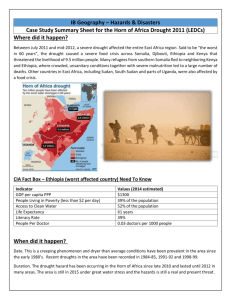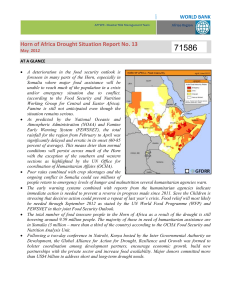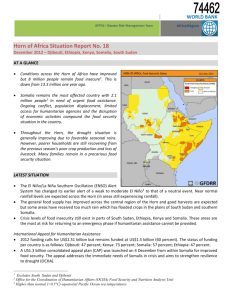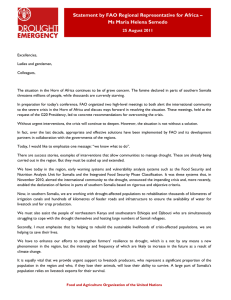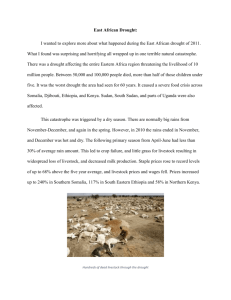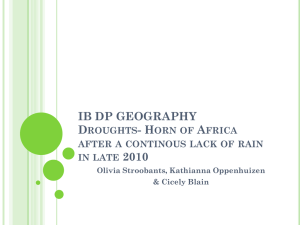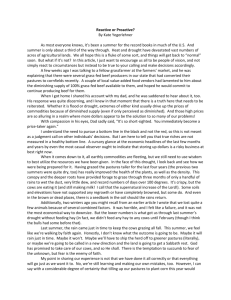DOC - Europa
advertisement
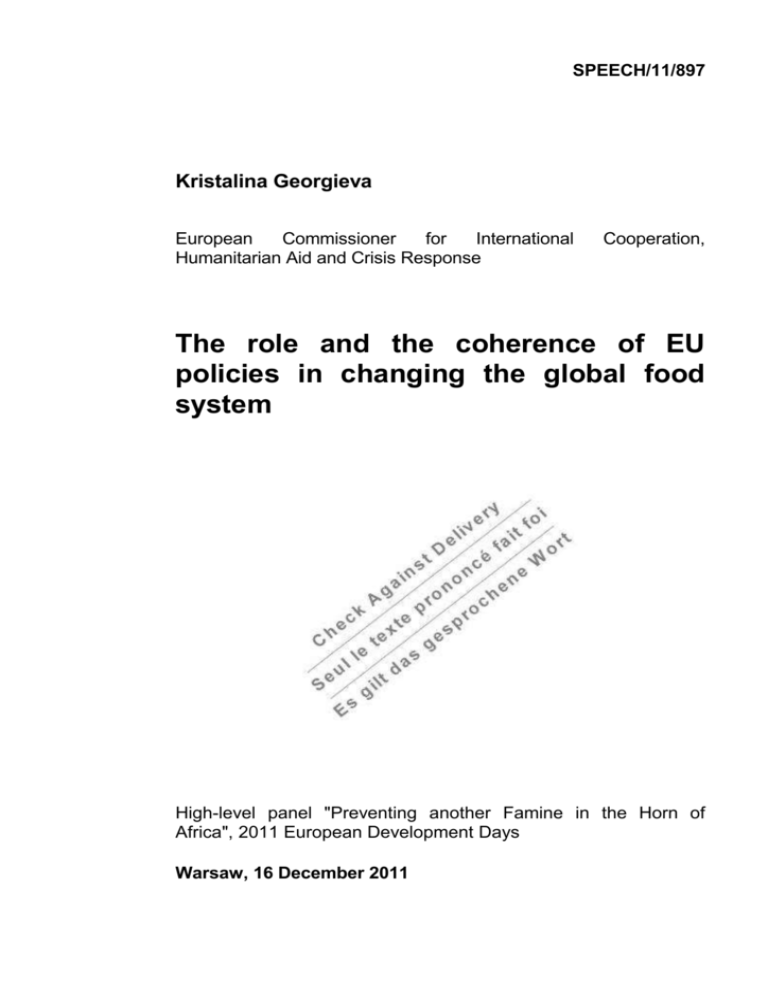
SPEECH/11/897 Kristalina Georgieva European Commissioner for International Humanitarian Aid and Crisis Response Cooperation, The role and the coherence of EU policies in changing the global food system High-level panel "Preventing another Famine in the Horn of Africa", 2011 European Development Days Warsaw, 16 December 2011 The famine in the Horn of Africa is the greatest humanitarian crisis that the world is facing. Over 13 million people have been affected. Hundreds of thousands have been displaced. Tens of thousands have already died. The rains have come to the region and have provided some relief. But they have brought their own problems making humanitarian operations in Kenya and Somalia extremely difficult. There has been a rise in the transmission of water borne diseases such as cholera. And after months without water much of the region is suffering from heavy flooding. In Kenya alone more than 80,000 people have been displaced. In Somalia the banning by Al Shebaab of 16 Aid agencies is likely to have a devastating impact. The situation on the ground remains unclear but initial estimates are that between 400.000 and 600.000 people will no longer receive food assistance. These latest developments make it likely that famine will return to regions that had recently seen improvements and it will be the most vulnerable groups – women, children, the elderly - that are hit hardest. Faced with an unprecedented crisis traditional donors have already responded with generosity. The European Union has provided over €700 million in 2011. We have also seen the very generous and welcome contribution of new donors that include Turkey and the Organisation of Islamic Cooperation. But the magnitude of the crisis means that more immediate humanitarian assistance will be certainly needed. And even now the rains have come the poisonous legacy of this drought will remain. Families have been made destitute and forced into poverty. Malnutrition has blighted a generation of children and will, in the long term, slow the development of the Horn. In Kenya, it has been estimated the impact of malnutrition on lost productivity will cost 2-3% of GDP by 2030. In the Horn of Africa two consecutive failures of the rains led to the worst drought in 60 years. The result was food insecurity, malnutrition and famine. But the reason why the drought was so devastating is because it was combined with other problems facing the region: high vulnerability of certain groups, the conflict in central-south Somalia, rapid population growth, insufficient governance and steadily increasing food prices. To prevent a famine in the future all of these issues will need to be addressed. National strategies need to be developed to build infrastructure, to provide basic services, to deliver social protection, and to ensure food security when conditions are really bad. It is through measures like this that vulnerability can be reduced, the level of coping capacities of the population increased. In Ethiopia, Kenya, Eritrea, Uganda, as well as in Somalia, agriculture, rural development or food security has been selected as a focal sector for EU development cooperation. Since 2006, the Commission's Humanitarian Department has supported pilot projects for drought risk reduction in the Horn of Africa aimed at addressing local gaps and increasing local resilience. We have funded interventions such as early livestock destocking, rehabilitation of water dams, and management of rangelands. We have also set up structures that allow early responses when the emergency strikes: such as mobile clinics, distribution of food vouchers and water trucking. Communities have also been supported to form Drought Resilience Committees made up of community leaders and representative from local organisations. These Committees are responsible for community preparedness for traditional early warning systems. For instance, the Committees may advise pastoralists to reduce the size of their herds whenever there is a looming drought. They are also responsible for joint management of pasture and water. 2 Some of our Drought Resilience programmes are of a cross-border nature. This approach has helped bridge warring communities by ensuring a sharing of resources. In Sololo for instance, two warring clans, the Oromo of Ethiopia and the Borana of Kenya, have come together to rehabilitate a water pan and share the water during times of drought. Peace committees have lessened the hostilities between rival clans. €70 MEUR has already been invested in the arid regions of the Horn of Africa. The pilot projects have been a success and we are now on the 5th cycle of funding. A further €20 million has been allocated for 2012. But even the most successful pilot projects will fail in their attempts to increase the resilience of the communities if they are not integrated into sustainable drought management programmes that are managed by local institutions and are adequately supported by donor and national funding. Climate change is a fact and droughts will become more frequent and more severe in regions like the Horn and the Sahel (which is also facing a drought after the failure of the rains). But the consequences of climate change can be anticipated and planned for. "Drought cannot be prevented. Famine can". We live in a world of fragility. We need to understand and accept this fragility and to invest in long term solutions to build up resilience and to stop drought and famine becoming a recurrent crisis. There are many EU policies that can - and are - playing a role in developing drought resilience in the Horn or Africa. Overall, the best way to develop resilience is through economic development. Here, the EU as a whole is the biggest single donor of development assistance to the Horn. And finding a way to end the 20 years of conflict that have plagued Somalia will be a pre-requisite for moving the country beyond being a failed state and towards a future where effective investments in drought resilience can begin. Here I am very pleased that civil society initiatives - such as the Charter to End Extreme Hunger – underline that violence is one of the principle causes of mass starvation. Governments need to engage in diplomacy to end conflict and working toward peace in Somalia is one of the diplomatic priorities for the EU. As I mentioned, food security already takes a prominent place in the cooperation programmes financed by the EU. But this year's famine is the proof that much more needs to be done. I have been working very closely with Commissioner Piebalgs in this are and together we are committed to using all the tools at our disposal to put in place a strategic framework in order to deliver sustainable resource management and bring the Horn towards food and nutrition security (MDG1). We are aiming to develop a framework where humanitarian interventions are closely linked with development assistance. We will look to build upon national plans and programmes. We will aim to do so over a long-term perspective - up to 10 years. And we will look to the combine the efforts made by the European Commission with those by EU Member States as the work of international agencies and other development partners (including IGAD and NGOs). As a first step we will prioritise recovery activities in the drought affected areas. This will mean supporting actions such as sustainable land and water management, (micro)irrigation, livestock management, drought preparedness mechanisms, and nutrition. 3 From the pilot project that we have been running there is already plenty of evidence that specific policies on drought prevention can work. We have many success stories and these initiatives now need to replicated throughout all drought prone regions. A second stage of the programme will focus investments in sustainable agricultural and food security. Support areas would include: livelihood diversification, infrastructure investments (rural roads, adapted irrigation, storage facilities), training and education, private sector development (agro-dealers, rural finance, marketing). We would also look to research and pilot innovative techniques and mechanisms: from drought resistant crops to agri-insurance schemes. Ladies and Gentlemen, We need a short term response to this famine and we need a long term approach to develop resilience to future droughts. And if we are able to align the different policy instruments that the EU – Commission and Member States – have at our disposal we will have a good chance of putting the structures in place to end famine in the Horn of Africa. 4
